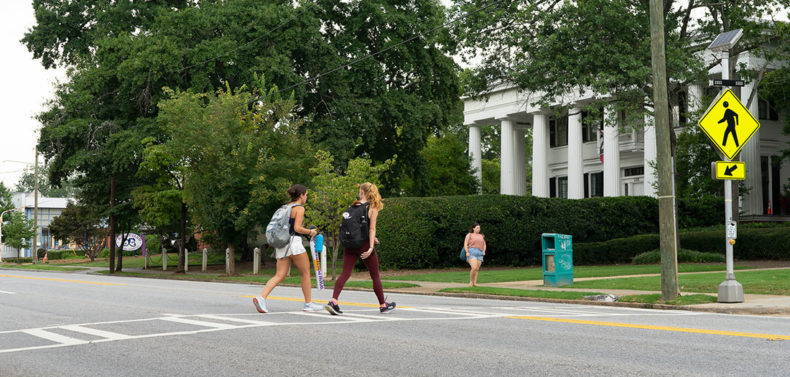Prince Avenue is an important extension of downtown Athens, connecting Normaltown, the UGA Health Sciences Campus and Piedmont Athens Regional Medical Center. Along the street are retail businesses, restaurants and medical offices, as well as historic 19th century residences. It carries a high volume of traffic—passenger cars, commercial vehicles, buses, cyclists and pedestrians.
In 2018 improvements to Prince Avenue were approved by the voters as a TSPLOST project. The proposal included $4 million to redesign major intersections and minor access points, and add pedestrian/bicycle facilities. The rationale is “to provide a more safe, efficient and effective transportation corridor for pedestrians, bicyclists, transit and vehicles.”
A user group was formed consisting of citizens and Athens-Clarke County staff. The Prince Avenue user group was charged with making suggestions for improvements based on input from consultants and other professionals regarding the best practices and possible solutions to the corridor’s limitations and needs. The user group began meeting in November 2020, and will continue this work until the project is completed.
There have been at least eight separate studies of Prince Avenue in the past three decades. In 1994, the Athens-Clarke County Planning Department published the 99-page Prince-Dougherty Corridor Study to “facilitate further analysis, and recommendations concerning the preservation and improvement of the corridor by the Historic Preservation Commission, ACCORTS [a regional transportation board] and other groups in the community.” One of the study’s recommendations was the connection of the inner Loop to Sunset Avenue at Prince Avenue, which was subsequently implemented. Another important effort was the 2004 Community Approach to Planning Prince Avenue (CAPPA), which involved ACC staff and elected officials, business owners, UGA, Athens Regional Medical Center and residents.
The TSPLOST user group sorted through the recommendations of various studies and came up with a ranked list of ways to improve Prince Avenue. A road diet from Milledge Avenue to Pulaski Street—a reduction from four lanes to three lanes—appeared as a Tier 1 project in the prioritized project list approved by the Mayor and Commission last February.
A major component of the TSPLOST project for Prince Avenue was approved this month by the Mayor and Commission: a pilot study to test a road diet on part of the street, with extensive collection of traffic data and public feedback. It is important for the public to understand the intentions of the pilot project and its limited nature, both in terms of physical length and duration.
This pilot, scheduled to begin in mid-September and run for 60 days, will be constructed from Pulaski Street to just east of Milledge Avenue. The redesign will consist of two travel lanes, a center turn lane and bike lanes on either side of the road with protective barriers. Data will be collected on traffic counts, speeds and delays, as well as the diversion of traffic onto other streets. There will also be a comprehensive public engagement effort like the one that supported the 2018 Athens in Motion plan.
This new lane configuration will affect all users of the roadway. By providing a separate turn lane, the likelihood of rear-end collisions and of cars making quick and unexpected lane changes to avoid turning cars should be reduced. Speeds should also decrease, it should be easier for pedestrians to cross, and it should be easier for cars to turn left into traffic from a side street. Protected bike lanes are intended to separate cyclists from cars and pedestrians.
Similar projects in other communities have been documented to make roads safer for all users, and to reduce illegal speeding, with minimal increases in congestion. During the most recent five-year period, Prince Avenue between Pulaski and Milledge had 184 crashes, including 14 involving vulnerable road users who were walking or on a bike, and 46 involved injuries. A report from the Federal Highway Administration found that road diets reduce crashes by 29%.
The 2014 Georgia Department of Transportation Prince Avenue Road Safety Audit reached the conclusion that traffic speeds on Prince Avenue are too high, and that this makes the street more dangerous for all users. The audit noted a lack of protection for cyclists and insufficient pedestrian crossings, and it recommended implementing a road diet from Milledge Avenue to Pulaski Street to lower speeds approaching downtown.
In 2019, GDOT (which controls the portion of Prince Avenue from the Loop to Milledge Avenue), notified ACC that they are going to resurface Prince Avenue from Sunset Avenue all the way to Pulaski Street sometime in the next few years and provide upgrades to intersections and pedestrian ramps at crosswalks. These improvements are funded by GDOT partly through a federal pedestrian safety grant, and they complement the TSPLOST project for Prince Avenue. They should include signal and crosswalk upgrades, new mid-block crossings, resurfacing and restriping, and a median in parts of Normaltown. GDOT is expected to host an online public information open house to gather public input on their project.
Four years ago, Athens made a commitment to improving transportation infrastructure through the implementation of the Athens in Motion Bicycle and Pedestrian Master Plan (accgov.com/7604/Athens-In-Motion-Bicycle-Pedestrian-Mast). This plan provides a strategy for near- and long-term projects that will result in a safe, connected and equitable bike and pedestrian network for Athens-Clarke County.
At the same time, the statewide 2018 GDOT Bicycle Safety Action Plan called out Prince Avenue as a prime example of the type of road that is dangerous for walkers and cyclists, and that needs improvement. That same report found that on a per capita basis, Athens-Clarke County had the highest rates of bicycle crash injuries and fatalities of any county in the state.
The Prince Avenue story fits into a larger narrative. Between 2010–2019, pedestrian deaths in the U.S. increased by approximately 50%, and cyclist deaths increased by over 30%. The story is very different in countries in Europe that have invested in multimodal street design. In fact, during the same period, pedestrian and cyclist deaths have declined in countries all over Europe. Compared with countries like Denmark, Germany and the Netherlands that have great infrastructure, walking and cycling a mile is about five times more likely to get you killed in the U.S. The reasons for this disparity include higher speeds, larger vehicles and, most importantly, road design—the lack of protected bike lanes, few visual cues to drive slower and poorly designed crosswalks.
The TSPLOST pilot project is designed to determine whether a new configuration of Prince Avenue will enhance the transportation network in Athens. The user group has spent over a year discussing possible designs, with input from traffic engineers and street safety consultants. The project hopes to achieve increased safety without causing unreasonable delays and diversions. If it is successful, the pilot could be made permanent by a vote of the Mayor and Commission and paid for through TSPLOST funds.
This article was written by Mark Ebell, Clint McCrory and Ellen Walker.
Like what you just read? Support Flagpole by making a donation today. Every dollar you give helps fund our ongoing mission to provide Athens with quality, independent journalism.







